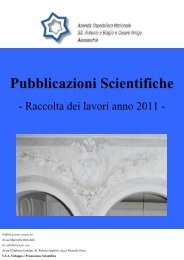Working Paper of Public Health Volume 2012 - Azienda Ospedaliera ...
Working Paper of Public Health Volume 2012 - Azienda Ospedaliera ...
Working Paper of Public Health Volume 2012 - Azienda Ospedaliera ...
Create successful ePaper yourself
Turn your PDF publications into a flip-book with our unique Google optimized e-Paper software.
<strong>Azienda</strong> <strong>Ospedaliera</strong> Nazionale“SS. Antonio e Biagio e Cesare Arrigo”<strong>Working</strong> <strong>Paper</strong> <strong>of</strong> <strong>Public</strong> <strong>Health</strong>nr. 6/<strong>2012</strong>3. Issues with the psychological autopsyThe psychological autopsy was seen as being ‘scientific’ and hence, unassailable. However,shortcomings have been reported.These are retrospective studies and retrospective studies are not accepted as being <strong>of</strong> highscientific value in any area <strong>of</strong> social science. Many (Robbins, 1984) did not include controlsamples. Those who gather and evaluate the information used in psychological autopsies havean investment in the outcome <strong>of</strong> these studies, and while we aspire to objectivity, avoidingbias is always a difficult task (Selkin & Loya, 1979). There are different types <strong>of</strong>psychological autopsy (Scott et al, 2006), leading some authors to state that one study cannotbe compared to another (Abondo, et al, 2008). Many authors have raised concern about thevalidity and reliability (Ogl<strong>of</strong>f and Otto, 1993; Biffl, 1996; Hawton et al, 1998a; Werlang &Botega, 2003, Snider et al, 2006). In addition, Pouliot & De Leo (2006) state that “the vastmajority have used ill-defined instruments”, which means the formulas used to make thediagnoses <strong>of</strong> mental disorder in “the vast majority” studies were probably not valid.In view <strong>of</strong> these and other objections and the frequent findings in Asia that mental disorderwas frequently found to be absent in over 50% <strong>of</strong> completed suicides (Phillips, 2010), therehave been recommendations to standardize psychological autopsies (Conner et al, 2011&<strong>2012</strong>). While this may help in future studies, the impression is now created that the solutionto suicide is medical, and will take a long time to correct.3. Sociological/sociocultural autopsyEmile Durkheim (1897) wrote what may still be called the most important contribution tosuicide studies. While he acknowledged that in some cases, suicide was the result <strong>of</strong> mentaldisorder, he contended the major factors were sociological: the ability <strong>of</strong> society to give theindividual values and goals, and the degree <strong>of</strong> integration (attachment) gained by theindividual from society. He described ‘anomie’ a situation in society where the usual rulesand regulations do not apply and people lack a moral compass – he described this occurringduring the Industrial Revolution and other periods <strong>of</strong> social upheaval. It is seen withdevastating effect today in the high suicide rate <strong>of</strong> some disadvantaged indigenous people(Pridmore & Fujiyama, 2009).Durkheim (1897) also described egoistic suicide. This has been much misunderstood. Inegoistic suicide the individual has inadequate ‘integration’, meaning attachments and support3


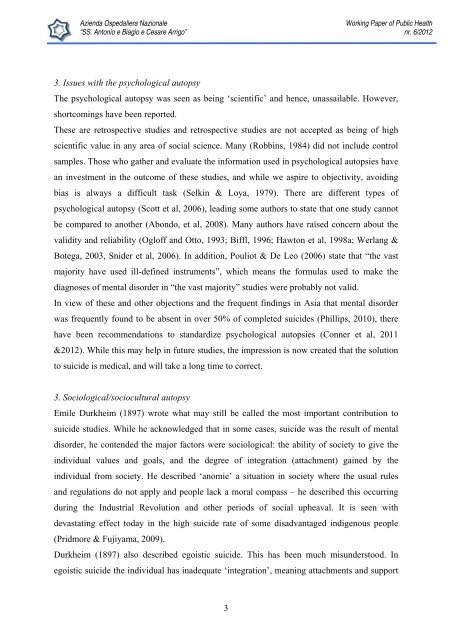
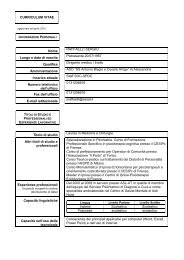
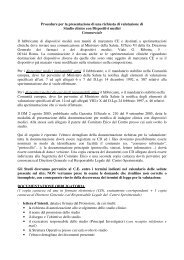

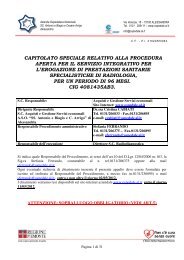
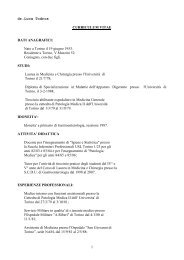





![[torino - 1] lastampa/urc/01 ... 26/10/09 - Azienda ...](https://img.yumpu.com/44058002/1/190x32/torino-1-lastampa-urc-01-26-10-09-azienda-.jpg?quality=85)

